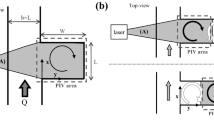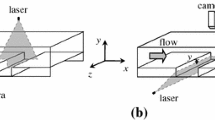Abstract
The interaction between a laminar boundary layer and an open cavity is investigated experimentally for medium range Reynolds numbers. Flow visualizations are carried out for three different observation directions in order to understand the spatial development of dynamical structures. In particular, synchronized visualizations in two parallel planes picture the transverse development of the flow. The study is conducted by changing the cavity aspect ratio, the Reynolds number and therefore the flow patterns inside the cavity. The issue is to emphasize the 3-D development of the flow. In particular, we show that the dynamical structures are not due to secondary shear layer instabilities.






















Similar content being viewed by others
Abbreviations
- A :
-
plate length upstream of the cavity
- B :
-
plate length downstream of the cavity
- D :
-
wind tunnel height
- Gö :
-
Görtler number
- H :
-
cavity height
- k :
-
wave number
- L :
-
cavity length
- R :
-
aspect ratio
- r c :
-
curvature radius
- Re :
-
Reynolds number
- S :
-
wind tunnel span
- t :
-
time
- U c :
-
convection velocity inside the cavity
- U e :
-
external velocity
- (x, y, z):
-
Cartesian coordinates
- Δ:
-
difference
- δ:
-
boundary layer thickness inside the cavity
- δ2 :
-
momentum thickness inside the cavity
- Λ:
-
dimensionless coefficient
- λ:
-
wavelength
- ν:
-
kinematics viscosity
References
Beaudoin JF, Cadot O, Aider JL, Weisfreid JE (2004) Three-dimensional stationary flow over a backward-facing step. Eur J Mech B Fluids 23:147–155
Bilanin AJ, Covert EE (1973) Estimation of possible excitation frequencies for shallow rectangular cavities. AIAA J 11(3):347–351
Bippes H (1972) Experimentelle Untersuchung des laminar-turbulenten Umschlags an einer parallel angeströmten könkaven Wand. Heidel. Akad. Wiss. Naturwiss. Kl. 3:103 (also NASA TM-75243, 1978)
Chang CH, Meroney RN (2003a) The effect of surroundings with different separation distances on surface pressures on low-rise buildings. J Wind Eng Ind Aerodyn 91:1039–1050
Chang CH, Meroney RN (2003b) Concentration and flow distributions in urban street canyons: wind tunnel and computational data. J Wind Eng Ind Aerodyn 91:1141–1154
Chatellier L, Laumonier J, Gervais Y (2004) Theoretical and experimental investigations of low Mach number turbulent cavity flows. Exp Fluids 36:728–740
Chung KM (2001) Three-dimensional effect on transonic rectangular cavity flows. Exp Fluids 30:531–536
Dezsö-Weidinger G, Stitou A, Van Beeck J, Riethmuller ML (2003) Measurements of the turbulent mass flux with PTV in a street canyon. J Wind Eng Ind Aerodyn 91:1117–1131
Fang LC, Nicolaou D, Cleaver JW (1999) Transient removal of a contaminated fluid from a cavity. Int J Heat Fluid Flow 20:605–613
Floryan JM, Saric WC (1982) Stability of Görtler vortices in boundary layers. AIAA J 20(3):316–324
Forestier N, Jacquin L, Geffroy P (2003) The mixing layer over a deep cavity at high-subsonic speed. J Fluid Mech 475:101–145
Geveci M, Oshkai P, Rockwell D, Lin JC, Pollack M (2003) Imaging of the self excited oscillation of flow past a cavity during generation of a flow tone. J Fluids Struct 18:665–694
Gharib M, Roshko A. (1987) The effect of flow oscillations on cavity drag. J Fluid Mech 177:501–530
Ghia U, Ghia KN, Shin CT (1982) High-re solutions for incompressible flow using the Navier-Stokes equations and a multigrid method. J Comput Phys 48:387–411
Grace SM, Dewar WG, Wroblewski DE (2004) Experimental investigation of the flow characteristics within a shallow wall cavity for both laminar and turbulent upstream boundary layers. Exp Fluids 36:791–804
Guermond JL, Migeon C, Pineau G, Quartapelle L (2002) Start-up flows in a three-dimensional rectangular driven cavity of aspect ratio 1:1:2 at Re = 1000. J Fluid Mech 450:169–199
Hall P (1983) The linear development of Görtler vortices in growing boundary layers. J Fluid Mech 130:41–58
Heller HH, Bliss B (1975) The physical mechanism of flow-induced pressure fluctuations in cavities and concepts for their suppression. AIAA Paper 75–491, 2nd Aeroacoustics Conference, Hampton
Howe MS (2003) Mechanism of sound generation by low Mach number flow over a wall cavity. J Sound Vib 273:103–123
Huerre P, Rossi M (1998) Hydrodynamic instabilities in open flows. In: Godrèche C, Manneville P (eds) Hydrodynamics and nonlinear instabilities. Cambridge University Press, pp 81–294
Kegerise MA, Spina EF, Garg GS, Cattafesta LN III (2004) Mode-switching and nonlinear effects in compressible flow over a cavity. Phys Fluids 16(3):678–687
Komerath NM, Ahuja KK, Chambers FW (1987) Prediction and measurement of flows over cavities—a survey. AIAA Paper 87–0166
Koseff JR, Street RL (1984) Visualization studies of a shear driven three-dimensional recirculating flow. J Fluids Eng 106:21–29
Kuo CH, Chang CW (1998) Shear-layer characteristics across a cavity with a horizontal top plate. Fluid Dyn Res 22:89–104
Kuo CH, Jeng WI (2003) Lock-on characteristics of a cavity shear layer. J Fluids Struct 18:715–728
Larchevêque L, Sagaut P, Lê TH, Comte P (2004) Large-eddy simulation of a compressible flow in a three-dimensional open cavity at high Reynolds number. J Fluid Mech 516:265–301
Lin JC, Rockwell D (2001) Organized oscillations of initially turbulent flow past a cavity. AIAA J 39(6):1139–1151
Mendoza JM, Ahuja KK (1995) The effect of width on cavity noise. J Aircr 14(9):833–837
Migeon C (2002) Details on the start-up development of the Taylor-Görtler-like vortices inside a square-section lid-driven cavity for 1,000 ≤ Re ≤ 3,200. Exp Fluids 33:594–602
Migeon C, Pineau G, Texier A (2003) Three-dimensionality development inside standard parallelepipedic lid-driven cavities at Re = 1000. J Fluids Struct 17:717–738
Pastur L, Westra MT, Van de Water W (2003) Sources and sinks in 1D travelling waves. Physica D 174:71–83
Rockwell D (1983) Oscillations of impinging shear layers. AIAA J 21(5):645–664
Rockwell D, Naudascher E (1978) Review self-sustained oscillations of flow past cavities. J Fluids Eng 100:152–165
Rossiter JE (1964) Wind-tunnel experiments on the flow over rectangular cavities at subsonic and transonic speeds. Aeronautical Research Council Reports and Memoranda 3438
Rowley CW, Colonius T, Basu AJ (2002) On self-sustained oscillations in two-dimensional compressible flow over rectangular cavities. J Fluid Mech 455:315–346
Sarohia V (1977) Experimental investigation of oscillations in flows over shallow cavities. AIAA J 15(7):984–991
Swearingen JD, Blackwelder RF (1987) The growth and breakdown of streamwise vortices in the presence of a wall. J Fluid Mech 182:255–290
Tam CKW, Block PJW (1978) On the tones and pressure oscillations induced by flow over rectangular cavities. J Fluid Mech 89:373–399
Tani I (1962) Production of longitudinal vortices in the boundary layer along a concave wall. J Geophys Res 67:3075–3080
Umesh Chandra B, Chakravarthy SR (2005) Experimental investigation of cavity-induced acoustic oscillations in confined supersonic flow. J Fluids Eng 127:761–769
Van Hecke M, Storm C, Van Saarloos W (1999) Sources, sinks and wavenumber selection in coupled CGL equations and implications for counterpropagating wave systems. Physica D 134:1–47
Winoto SH, Crane RI (1980) Vortex structure in laminar boundary layers on a concave wall. Int J Heat Fluid Flow 2:221–231
Author information
Authors and Affiliations
Corresponding author
Rights and permissions
About this article
Cite this article
Faure, T.M., Adrianos, P., Lusseyran, F. et al. Visualizations of the flow inside an open cavity at medium range Reynolds numbers. Exp Fluids 42, 169–184 (2007). https://doi.org/10.1007/s00348-006-0188-8
Received:
Revised:
Accepted:
Published:
Issue Date:
DOI: https://doi.org/10.1007/s00348-006-0188-8




